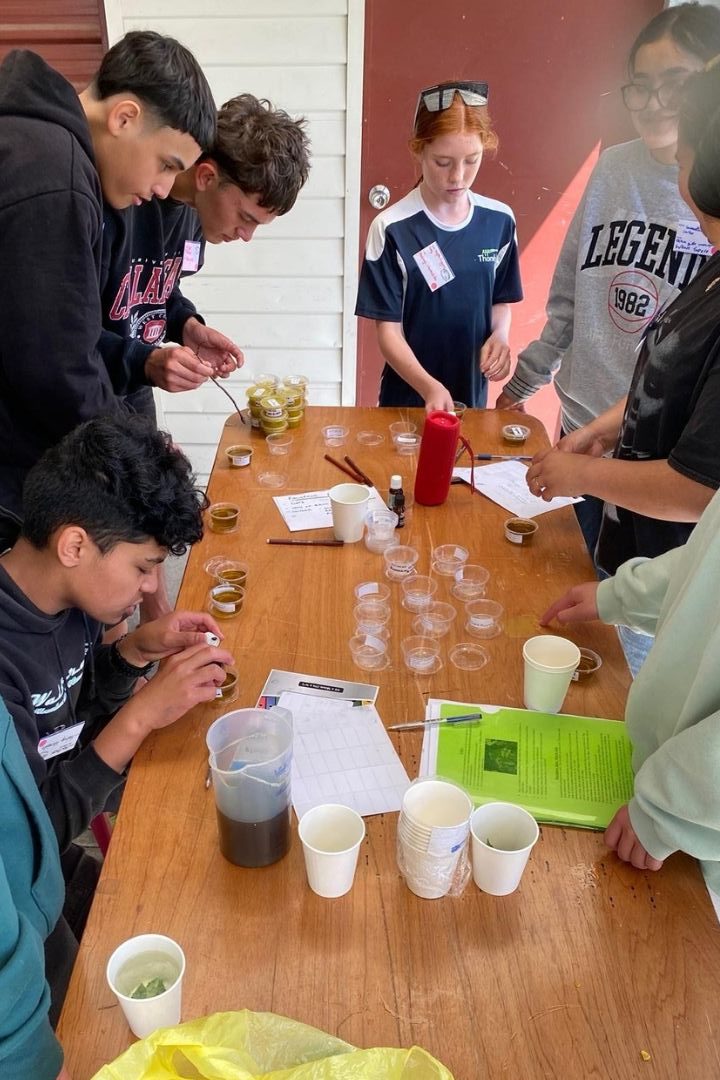
16 Nov Nurturing the Seeds of Education: Science Wānanga at Houngarea Marae
Growing up in Heretaunga and being heavily sports-orientated, there wasn’t much opportunity to experience and engage with the endless avenues of science or tertiary education. However, with the experiences I’ve gained and the connections I’ve forged along the journey, I find myself impassioned to tautoko the pursuit of higher education in our rangatahi Māori in whichever domains they choose to explore. So, when an opportunity presented itself from a friend who I met along the way in my journey, Mariana Te Pou, I jumped.
Mariana is Kaituitui Wānanga at the University of Otago and delivers marae-based science outreach wānanga to Māori communities across the motu. This year, the wānanga was hosted by Houngarea Marae in Pakipaki, gathering 45 tauira Māori, years 7 to 10, from Hastings Intermediate, Hastings Boys’ High School, Te Kura Kaupapa Māori o Te Ara Hou, and Te Kura Kaupapa o te Wānanga Whare Tapere o Takitimu. We also had 22 tamariki from Te Kura o Pakipaki join in and engage in our activities. The kaupapa of the wānanga was whakapapa: “E kore au e ngaro, he kakano ahau i ruia mai i Rangiatea.”
Day one consisted of three workshops. First, we dove into the intricate world of the Covid infection and how it spreads. Next, rangatahi embarked on extracting DNA and understanding the process using strawberries. Finally, we had a rongoā workshop where rangatahi made their own kawakawa balm. As the sun settled on the horizon, the evening was filled with a very competitive quiz, pictionary, and charades night where rangatahi showcased their strengths against tuakana and kaiako.
Day two was a whirlwind of discovery. Three rotations of workshops took us on a journey through awa and testing of the wai, DNA testing, and an exploration of how whakapapa can help track and trace a generational illness genes. Lastly, the rangatahi reveled in a whakaahua workshop, where they depicted themselves as a tipuna, many of them in captivating artistry.


That afternoon we went to the recently unveiled Waiaroha, a water treatment and storage facility in Hastings. Here, Matua Charles Ropitini and Whaea Hira Huata graced us with a beautiful kōrero, explaining the sacredness of the whenua in which Waiaroha is built on. Beneath the ground, a pair of bore fields and an aquifer whispered ancestral tales. The rangatahi got to explore water pumps, tūpuna knowledge, and the endless cycle of wai: from evaporation to transpiration and condensation, to a drop’s descent onto the maunga, the journey to the awa, and its ultimate embrace by the moana. We had an incredible time and were the first rōpū to be hosted at Waiaroha since its opening. The evening once again came alive with nightly kēmu, a fusion of Broken Telephone and Pictionary, igniting the fires of competitiveness again.
On our final day, the rangatahi applied their learnings over the last couple of days in an Amazing Race. In teams of four, they navigated around eight stations, each linked to the workshops that had been undertaken. Our final sharing of knowledge was in the form of waiata where the rangatahi and kaiako learnt Te Whakapapa o Te Wai, a waiata composed at a Kura Reo in Whirinaki, guided by Papa Rereata Makiha.
The wānanga concluded with a beautiful poroporoaki and farewells to the rangatahi and to our Ōtākou whānau, parting ways with the waiata that echoed through Pakipaki. The whakapapa of wai continues to flow, connecting us to our ancestors and to each other. As Matua Charles said, our wai knows us: as soon as we touch it, it knows exactly who we are. Ko wai au, nō wai au.
Te whakapapa ō te wai
Wainuiātea ka moe i a Tangotango
Ka puta ko Moana nui, Moana roa
Moana hākere, Moana pō-tango
Moana tū i te repo
Moana tū i te wao
Te whakapapa ō te wai

Chelsea Cunningham-McLean
Raised in Heretaunga, Chelsea is passionate about sport and physical activity. She is a former Growing the Puna intern.



